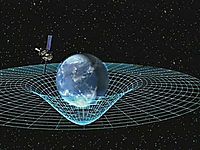
Photo from wikipedia
The mechanical and thermal behavior of nonisothermal fiber-filled composites in a three-dimensional printing process is studied numerically with a smoothed particle hydrodynamics method. A classical microstructure-based fiber suspension model with… Click to show full abstract
The mechanical and thermal behavior of nonisothermal fiber-filled composites in a three-dimensional printing process is studied numerically with a smoothed particle hydrodynamics method. A classical microstructure-based fiber suspension model with a temperature-dependent power-law viscosity model and a microstructure constitutive model is implemented to model a fiber-filled system. The fiber microstructure is described by a second-order tensor A2 which describes the spatially averaged orientation of the fibers. Two benchmark cases are presented to validate the reliability of the present implementation. Three typical printing modes are tested to assess the characteristics of printed layers. The results show that the printed layer becomes thicker, and the fiber alignment in the printing direction is enhanced in the bottom half of the layer and reduced in the top half due to the existence of nonisothermal effects in the process. The variation in fiber orientation becomes larger with increasing fiber concentration. By increasing the Peclet number, the deposited layer thickness reduces and the fiber alignment in the printing direction is enhanced in the top half and reduced in the bottom half. The evolution of the orientation and the velocity gradient tensors projected along several streamlines are discussed to illustrate the effects of the temperature and different printing modes on the deposited layer.
Journal Title: Physics of Fluids
Year Published: 2019
Link to full text (if available)
Share on Social Media: Sign Up to like & get
recommendations!